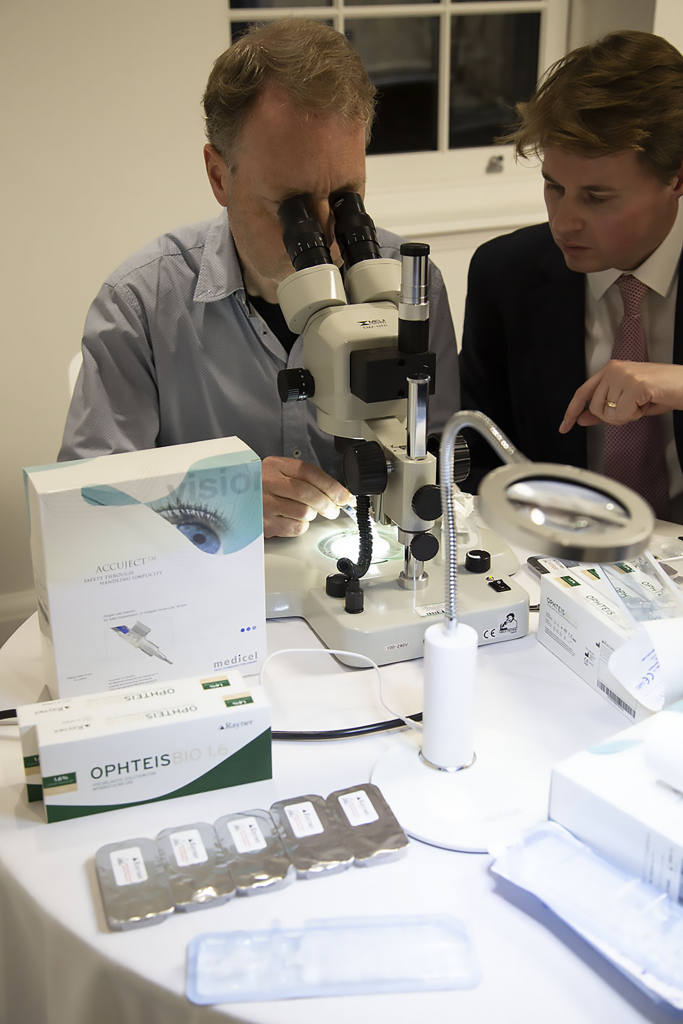Expanding trifocal technology
New sulcus-fixated trifocal IOL provides easy and reversible option for cataract patients and pseudophakes seeking spectacle independence

Roibeard O’hEineachain
Published: Wednesday, May 1, 2019
 Mr Mark Hulbert (The St Albans Eye Care and Vision Centre) with Warwick Strand, Vice President Marketing at Rayner[/caption]
At a surgical skills programme held by Rayner at Ophthalmic Consultants of London, UK, leading ophthalmologists introduced the new Sulcoflex trifocal lens. Designed with the same diffractive optics as the RayOne trifocal, the Sulcoflex Trifocal is the successor of the Sulcoflex refractive multifocal. Like the other additive lenses of the Sulcoflex platform, the lens can be implanted at the time of cataract surgery in a duet procedure or at later time. And unlike capsule-fixated multifocal IOLs, the sulcus-fixated Sulcoflex lens can also be easily removed if necessary.
“This lens is an additive lens, which means it is put into the eye in a pseudophakic situation. So, if you have a patient with some biometric surprise or something you can easily correct the refraction with sulcus-fixated add-on lens. That was the original idea of this lens platform, which is now more than 10 years old,” said Michael Amon MD, PhD, Head of the Academic Teaching Hospital of St John, and Chair of Ophthalmology at Sigmund Freud University, Vienna, Austria.
Six-month results
Dr Amon has carried out a single-surgeon initial trial in which he performed duet implantation of a capsule-fixated IOLs and Sulcoflex trifocals in 40 eyes of 20 patients. The study showed that at a follow-up of six-months, patients had a mean Snellen decimal uncorrected visual acuity of 1.2 for distance vision, 1.05 for intermediate vision and 1.45 for near vision.
He is also carrying out a trial involving the additive implantation of the Sulcoflex Trifocal lens in 40 pseudophakic eyes of 20 patients. As yet, the trial has not been completed, but as an example of the kind of results achieved so far, he presented the case of a 72-year-old pseudophakic woman who underwent bilateral implantation of the additive trifocal lens in September 2018.
He noted that at the most recent follow-up visit the patient has a distance visual acuity and near visual acuity of 0.7 and J1, respectively, in her right eye, and 1.0 and J1 in her left eye. He added that the results in the right eye were less than optimal because of secondary cataract and he will soon be performing a YAG laser capsulotomy.
Sulcoflex platform
Like the older Sulcoflex additive IOLs, the Sulcoflex trifocal is composed of Hydrophilic Rayacryl: HEMA-MMA copolymer, chosen for its high uveal and capsular biocompatibility. Moreover, optical bench studies show that the lens does not reduce the optical quality of the primary lens in the capsular bag, Dr Amon said.
Sulcoflex lenses have a 14mm diameter with undulating round-edged haptics and a 10-degree angulation that reduces the risk of contact with the posterior iris and pigmented epithelium. They have a round-edged 6.5mm optic to prevent optic-iris capture and reduce the likelihood of edge glare and dysphotopsias. In addition, the optic has a concave posterior surface to prevent contact between the IOL in the capsular bag and the Sulcoflex lens.
Mr Mark Hulbert (The St Albans Eye Care and Vision Centre) with Warwick Strand, Vice President Marketing at Rayner[/caption]
At a surgical skills programme held by Rayner at Ophthalmic Consultants of London, UK, leading ophthalmologists introduced the new Sulcoflex trifocal lens. Designed with the same diffractive optics as the RayOne trifocal, the Sulcoflex Trifocal is the successor of the Sulcoflex refractive multifocal. Like the other additive lenses of the Sulcoflex platform, the lens can be implanted at the time of cataract surgery in a duet procedure or at later time. And unlike capsule-fixated multifocal IOLs, the sulcus-fixated Sulcoflex lens can also be easily removed if necessary.
“This lens is an additive lens, which means it is put into the eye in a pseudophakic situation. So, if you have a patient with some biometric surprise or something you can easily correct the refraction with sulcus-fixated add-on lens. That was the original idea of this lens platform, which is now more than 10 years old,” said Michael Amon MD, PhD, Head of the Academic Teaching Hospital of St John, and Chair of Ophthalmology at Sigmund Freud University, Vienna, Austria.
Six-month results
Dr Amon has carried out a single-surgeon initial trial in which he performed duet implantation of a capsule-fixated IOLs and Sulcoflex trifocals in 40 eyes of 20 patients. The study showed that at a follow-up of six-months, patients had a mean Snellen decimal uncorrected visual acuity of 1.2 for distance vision, 1.05 for intermediate vision and 1.45 for near vision.
He is also carrying out a trial involving the additive implantation of the Sulcoflex Trifocal lens in 40 pseudophakic eyes of 20 patients. As yet, the trial has not been completed, but as an example of the kind of results achieved so far, he presented the case of a 72-year-old pseudophakic woman who underwent bilateral implantation of the additive trifocal lens in September 2018.
He noted that at the most recent follow-up visit the patient has a distance visual acuity and near visual acuity of 0.7 and J1, respectively, in her right eye, and 1.0 and J1 in her left eye. He added that the results in the right eye were less than optimal because of secondary cataract and he will soon be performing a YAG laser capsulotomy.
Sulcoflex platform
Like the older Sulcoflex additive IOLs, the Sulcoflex trifocal is composed of Hydrophilic Rayacryl: HEMA-MMA copolymer, chosen for its high uveal and capsular biocompatibility. Moreover, optical bench studies show that the lens does not reduce the optical quality of the primary lens in the capsular bag, Dr Amon said.
Sulcoflex lenses have a 14mm diameter with undulating round-edged haptics and a 10-degree angulation that reduces the risk of contact with the posterior iris and pigmented epithelium. They have a round-edged 6.5mm optic to prevent optic-iris capture and reduce the likelihood of edge glare and dysphotopsias. In addition, the optic has a concave posterior surface to prevent contact between the IOL in the capsular bag and the Sulcoflex lens.

 Professor David Gartry (Moorfields Eye Hospital)[/caption]
Patient selection is key
Appropriate patient selection is critical for success with multifocal IOLs. Therefore, the clinician should engage the patient in clear, open and honest communication and discuss the advantages and disadvantages of multifocality, explaining the need for a period of neuroadaptation, and the likelihood of some dysphotopsias, particularly in the early postoperative weeks, said Brian Little MD, London, UK.
“Patients should be made aware of the multifocal IOLs option, but it is wise to undersell it and let the patient persuade you. Motivation for spectacle independence is paramount. If patients are happy with their reading glasses, they should stick with them,” Dr Little said
When one is beginning with multifocal IOLs it is best to start with those patients who are most likely to have satisfactory visual outcomes, namely, presbyopic hyperopes. It is best to avoid the more complex case like low myopes’ eyes with high cylinder and extreme eyes. In addition, it is generally best to avoid patients with any serious ocular morbidities.
“Know your patient’s needs and expectations, know your patient’s eye, know your favoured IOL and get comfortable doing the easy cases,” he summarised.
Michael Amon: Michael.Amon@bbwien.at
Allon Barsam: https://www.oclondon.com/contact-us/
Brian Little: eye.surgeon@me.com
Professor David Gartry (Moorfields Eye Hospital)[/caption]
Patient selection is key
Appropriate patient selection is critical for success with multifocal IOLs. Therefore, the clinician should engage the patient in clear, open and honest communication and discuss the advantages and disadvantages of multifocality, explaining the need for a period of neuroadaptation, and the likelihood of some dysphotopsias, particularly in the early postoperative weeks, said Brian Little MD, London, UK.
“Patients should be made aware of the multifocal IOLs option, but it is wise to undersell it and let the patient persuade you. Motivation for spectacle independence is paramount. If patients are happy with their reading glasses, they should stick with them,” Dr Little said
When one is beginning with multifocal IOLs it is best to start with those patients who are most likely to have satisfactory visual outcomes, namely, presbyopic hyperopes. It is best to avoid the more complex case like low myopes’ eyes with high cylinder and extreme eyes. In addition, it is generally best to avoid patients with any serious ocular morbidities.
“Know your patient’s needs and expectations, know your patient’s eye, know your favoured IOL and get comfortable doing the easy cases,” he summarised.
Michael Amon: Michael.Amon@bbwien.at
Allon Barsam: https://www.oclondon.com/contact-us/
Brian Little: eye.surgeon@me.com
Tags: rayner
Latest Articles
Towards a Unified IOL Classification
The new IOL functional classification needs a strong and unified effort from surgeons, societies, and industry.
The 5 Ws of Post-Presbyopic IOL Enhancement
Fine-tuning refractive outcomes to meet patient expectations.
AI Shows Promise for Meibography Grading
Study demonstrates accuracy in detecting abnormalities and subtle changes in meibomian glands.
Are There Differences Between Male and Female Eyes?
TOGA Session panel underlined the need for more studies on gender differences.
Simulating Laser Vision Correction Outcomes
Individualised planning models could reduce ectasia risk and improve outcomes.
Need to Know: Aberrations, Aberrometry, and Aberropia
Understanding the nomenclature and techniques.
Organising for Success
Professional and personal goals drive practice ownership and operational choices.
Update on Astigmatism Analysis
Is Frugal Innovation Possible in Ophthalmology?
Improving access through financially and environmentally sustainable innovation.